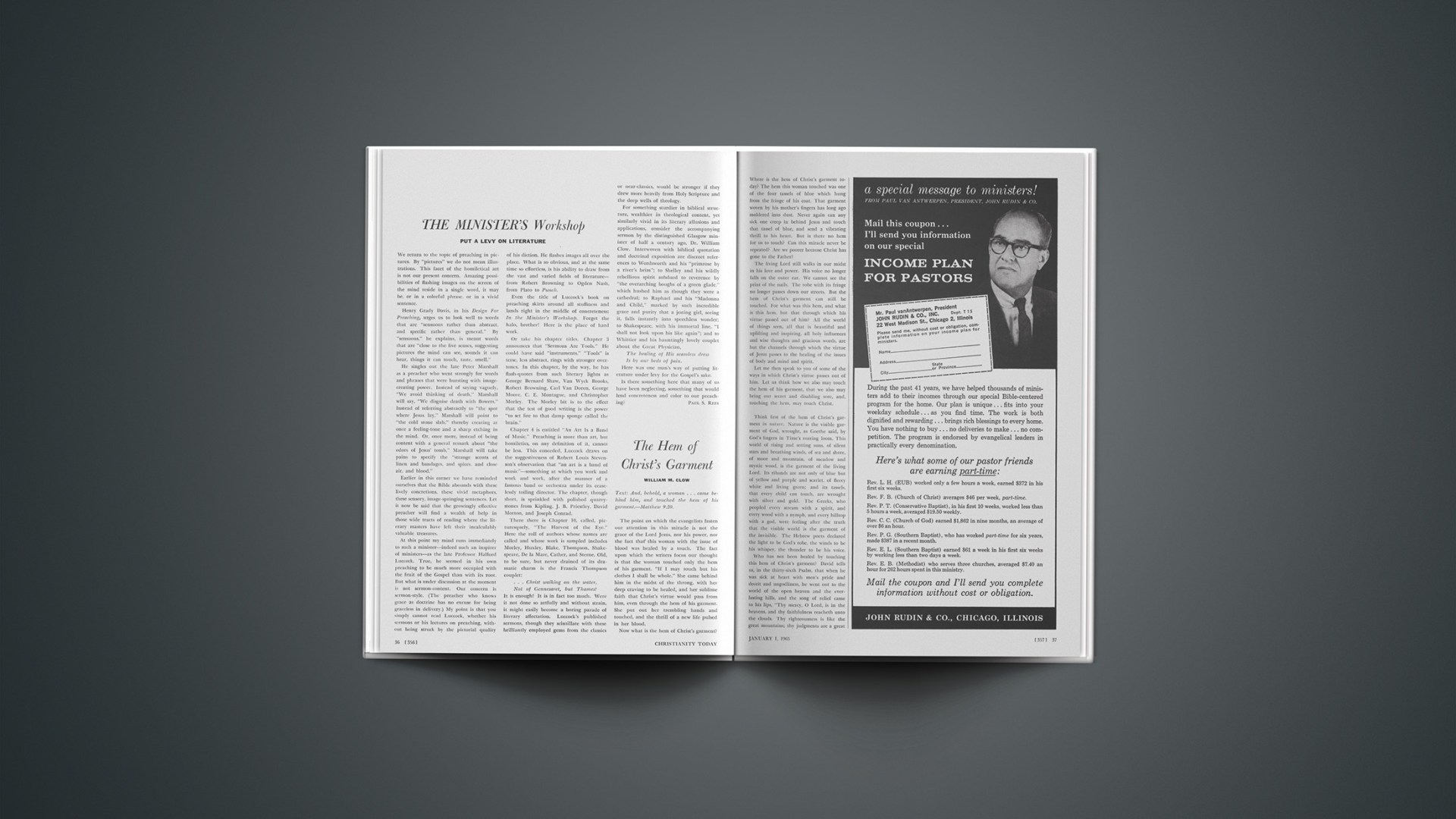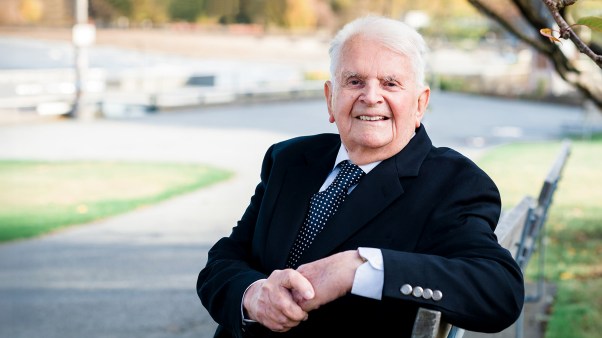Text: And, behold, a woman … came behind him, and touched the hem of his garment.—Matthew 9:20.
The point on which the evangelists fasten our attention in this miracle is not the grace of the Lord Jesus, nor his power, nor the fact that this woman with the issue of blood was healed by a touch. The fact upon which the writers focus our thought is that the woman touched only the hem of his garment. “If I may touch but his clothes I shall be whole.” She came behind him in the midst of the throng, with her deep craving to be healed, and her sublime faith that Christ’s virtue would pass from him, even through the hem of his garment. She put out her trembling hands and touched, and the thrill of a new life pulsed in her blood.
Now what is the hem of Christ’s garment? Where is the hem of Christ’s garment today? The hem this woman touched was one of the four tassels of blue which hung from the fringe of his coat. That garment woven by his mother’s fingers has long ago moldered into dust. Never again can any sick one creep in behind Jesus and touch that tassel of blue, and send a vibrating thrill to his heart. But is there no hem for us to touch? Can this miracle never be repeated? Are we poorer because Christ has gone to the Father?
The living Lord still walks in our midst in his love and power. His voice no longer falls on the outer ear. We cannot see the print of the nails. The robe with its fringe no longer passes down our streets. But the hem of Christ’s garment can still be touched. For what was this hem, and what is this hem, but that through which his virtue passed out of him? All the world of things seen, all that is beautiful and uplifting and inspiring, all holy influences and wise thoughts and gracious words, are but the channels through which the virtue of Jesus passes to the healing of the issues of body and mind and spirit.
Let me then speak to you of some of the ways in which Christ’s virtue passes out of him. Let us think how we also may touch the hem of his garment, that we also may bring our secret and disabling sore, and, touching the hem, may touch Christ.
Think first of the hem of Christ’s garment in nature. Nature is the visible garment of God, wrought, as Goethe said, by God’s fingers in Time’s roaring loom. This world of rising and setting suns, of silent stars and breathing winds, of sea and shore, of moor and mountain, of meadow and mystic wood, is the garment of the living Lord. Its ribands are not only of blue but of yellow and purple and scarlet, of fleecy white and living green; and its tassels, that every child can touch, are wrought with silver and gold. The Greeks, who peopled every stream with a spirit, and every wood with a nymph, and every hilltop with a god, were feeling after the truth that the visible world is the garment of the invisible. The Hebrew poets declared the light to be God’s robe, the winds to be his whisper, the thunder to be his voice.
Who has not been healed by touching this hem of Christ’s garment? David tells us, in the thirty-sixth Psalm, that when he was sick at heart with men’s pride and deceit and ungodliness, he went out to the world of the open heaven and the everlasting hills, and the song of relief came to his lips, “Thy mercy, O Lord, is in the heavens, and thy faithfulness reacheth unto the clouds. Thy righteousness is like the great mountains; thy judgments are a great deep.” Then his psalm rises higher, and breaks forth in the melody of a healed spirit. Wordsworth, as we know, often wandered lonely on the mountain-side, that he might walk with God in his temple. Shelley, rebellious spirit though he was, declared that the overarching boughs of a green glade were a cathedral, and taught him reverence. Samuel Cox narrates that when he was a youth, earning his bread among rough dock-laborers whose profanity fell with coarsening din upon his ears, he kept a flower upon his desk that he might be chastened and purified by coming into touch with God.
A great part of our earth is bare moor, waste wilderness, barren hillside, inaccessible mountain. God has made it so and kept it so. It is but the hem of his garment which wearied and broken men may touch. To walk abroad in some of these vast solitudes, to mark the bloom on the heather and the enchanting tints of the wild rose, and to hear the song of the lark, is to find a tonic for body and mind, and to realize that strength and calm are revisiting the soul. You said that nature healed you. It was not nature, it was God; and you were touching his garment’s hem.
Think, secondly, of the hem of Christ’s garment in art. By art I include all that is pure and lovely and noble in literature, in architecture, in music, in sculpture and painting, and in all the works of men done under the inspiration of the Spirit of God. There are few who have not felt nature to be the garment of God. But there are undiscerning eyes to which, as to Wordsworth’s dullard—
A primrose by a river’s brim
A yellow primrose was to him,
And it was nothing more.
There are some who never see a lovely hillside without thinking of it as a place to parcel out in profitable allotments. These are the soldiers who cast lots for Christ’s garment at the foot of the Cross. These are becoming fewer every day. Yet there are still many who do not realize that art is also the hem of Christ’s garment. You have gone to a noble music, weary, chafed, losing heart almost with yourself, and as you listened to some impassioned melody a great peace possessed you. Have you not in some dull and listless hour taken up a master in literature and read some story of love and grace, and of strenuous deed, or mused again over some poem which was full of light and truth, to find that your dullness had passed away? The depths within were broken up, tears came to your eyes, prayer was upon your lips, and you passed into the glorious liberty of the children of God.
How many have touched Christ through some great painting? I remember standing before Raphael’s “Madonna and Child,” which is the peculiar glory of the Dresden gallery. A company of tourists, careless in thought and light in speech, entered the room. As the solemn power of that great picture was felt, silence sealed every lip. The mingled majesty and simplicity of the Holy Child and the meek submission and saintly purity of the Virgin breathed forth an atmosphere of faith. One of the company, a young girl whose light laugh and jesting words had been ringing through the corridor, looked up to the picture with wonder and delight. Then a soft haze filled her eyes and she reverently bowed herself. It was not an act of devotion or of adoration of the picture. Her New England blood would not have allowed her to kneel. But she had touched the hem of the garment, and there flashed upon her the shallowness, and pettiness, and selfishness of the life which she was tempted to lead. In the instant, things low and mean and idle were smitten within her, and she was healed of her plague.
Art may be sordid in motive and base in purpose. It may become the garment of a leprosy, spotting not merely the flesh but the spirit. But art may be, and should be, the hem of Christ’s robe, through which, at the touch of need and reverence and faith, Christ’s virtue flows.
Think, thirdly, of the hem of Christ’s garment in the word. This is the tassel of blue which most have touched. If thousands have found Christ’s healing pass into them through nature and through art, tens of thousands have found still better healing through the inspired Scriptures of God. The Word of God is the closest garment of his thought. It is significant that Christ is called the Word, simply because God in Christ passed out to reveal himself, and to work his miracles, in and by a word. This Bible is something more than a book. A personality indwells in its pages. The roughest and rudest spirit will not lightly abuse a single page of it. One of our modern writers tells us of a man purposing a crime in which he will glut the revenge of his embittered spirit. As he sits in his room evolving his plans, his eyes fall upon a Bible. It seems a living thing. He shrinks back from it, but as he touches it his murderous hate is purged. He had simply brushed against the hem of the garment.
It was my duty some time ago to accompany to the place of burial the mourners of one of our beloved dead. As we stood round the open grave our eyes were held by a neighboring tombstone, on whose base there was cut the inscription—
He was a man, take him for all in all,
I shall not look upon his like again.
There are some occasions in life for which Shakespeare is not enough. A few yards away there stood a simpler gravestone, with the words, “Because I live, ye shall live also,” and those whose hearts were heavy found instant healing.
So in all times of need we can touch this hem. When we are tempted, we can, like Jesus, find a word through which our will shall be reinforced. When we need light and guidance, there is always some counsel that will show the path of truth and honor. When we require comfort, there are on every page the words of the only secure consolation the world knows. When we have lost hope and heart, and have tried many physicians, and are nothing better but rather grown worse, we have to turn and apply to our souls some great word out of this book to find ourselves healed—“Call upon me in the day of trouble: I will deliver thee,” or “Rest in the Lord, and wait patiently for him,” or “What I do thou knowest not now; but thou shalt know hereafter.”
The healing of his seamless dress,
Is by our beds of pain;
We touch him in life’s throng and press,
And we are whole again.
Think, fourthly, of the hem of Christ’s garment in the ministries of the Church. By the Church I mean the congregations of believing men and women, “the solemn troops and sweet societies,” bound together in the bonds of a common faith and love. By its ministries I mean the offices of psalm and prayer, the exposition of the Word, the power and helpfulness of its fellowship, the outgoing of sympathy and of inspiration in its service of God and of man. If there be anything earthly and visible which the most unspiritual man can see to be the garment of Christ, it is these gracious ministries of the Church. Sometimes they may seem dull to weariness. Too often they yield no blessing. The pool of healing is not always stirred. The bush is not always burning with hallowed fire. But surely no one ever took part in these ministries, and came with a need or a trouble, who did not receive strength and light and healing.
I marvel at the neglect of the public worship of God. I marvel at it the more in these busy and hustling and over-driven days, when men and women need so supremely a place of quiet, a time of meditation, an hour of recollection. I marvel that young men and women, in the years when the things that are beautiful are attractive to them, do not hunger after the beauty of holiness; and I marvel still more that the older men and women who are walking in those trying levels of middle life and are bearing the heat and burden of the day do not come eagerly to touch the hem of Christ’s garment. There are issues often shameful, sometimes secret, sometimes exhausting, which Christ heals through the ministries of the Church.
Here is a man who has come into God’s house bewildered about his duty, and as he prays he sees the way before him as in a vision. Here is a woman afflicted with fear about her life, or burdened by her deep anxiety for those dear to her. As she sits she catches the contagion of faith, and peace like a dove descends upon her. Here are young men and women tempted by this alluring world, feeling the rush within them of their hot young blood. They find themselves chastened, and their whole nature roused to choose the straight and narrow way. Even little children as they have sung their hymn have realized that they were touching Jesus.
Think, fifthly, of the hem of Christ’s garment in the sacrament of the Supper. Nothing else brings us so near Christ, and through nothing else does his virtue pass so immediately as the sacrament of the Lord’s Supper. Before the Church itself was organized, before a line of the New Testament was written, before even the Old Testament had become the book of light and leading to Christian men, the Lord’s Supper was the rite of constant use. It is this ordinance, so universal wherever Christian men are met, with its white cloth and bread and wine, which all men feel to be “the sight/Of a sweepy garment, vast and white,/With a hem that I could recognize.” This is the hem that all men recognize. At times a too great reverence has been paid to it. In the north of Scotland, the fine Celtic awe and reverence for sacred things has invested it with such sanctity that poor sin-sick men and women have not always dared to approach it for their healing. The Romish church has also felt its sacredness so keenly that they have called this hem of the garment by the very name of the Lord, and have forgotten that its bread and wine are only symbols and not the very flesh and blood of Jesus.
The Lord’s Supper is only the Supper, and its elements are only signs; but they are elements and signs through which there passes to repentant men the healing of the issues of their lives. What is the virtue which passes from Christ in this sacrament? It is the virtue of his death on the Cross. Had there been no Cross there might have been a supper of fellowship, but not a feast of healing. “Ye do shew the Lord’s death till he come,” and in showing it you touch the hem of his garment and are healed.
What do we bring, as penitents, to the Lord’s Supper? We bring the memory and conscience of our slip and fall, our broken vows, our unfulfilled resolves, our too feeble struggle with sin, our distaste for goodness and for God. “Let a man examine himself, and so let him eat.” These words are read in a silence which reveals that many find them searching and scaring. But they are the words of most gracious invitation. “Let a man examine himself”—of his envy and pride, and passion, and ill will to his neighbor, and dishonesty, sickness of soul and its issue of shame in his life—and “so let him eat, and eating, be healed.”
What sore and shameful issue is draining you of strength and peace and hope? How many, like this woman, are the subjects of chronic sin? Chronic weakness against temptation, chronic habits of sloth, chronic distrust and doubt, chronic prayerlessness; how these, and similar sins, drain our lives of gladness! How many have ceased to expect or to hope to be holy, and have become content with a life of a mean level of morality? All of us may be healed by touching this hem of his garment in an appealing faith.
But no healing, be it remembered, comes from nature or art, or the word, or the ministries of the Church, or even from this sacrament, in themselves. Do not, I beseech you, play the idolator with any of them. They may be only dead and bare signs. It is the Lord who healeth us. It is his power, his grace, his Cross; and these are but the hem of his garment through which his healing flows. When we come, in faith on him, to touch any one of them, virtue will pass out of him.—Chapter 23, “The Hem of Christ’s Garment,” from The Cross in Christian Experience, by William M. Clow (London: Hodder & Stoughton, 1908). Used by permission.
Plans have been unveiled for a ten-day meeting, conceived as a potential landmark in Christian history, which will bring together 1,200 influential churchmen from around the world to discuss evangelism. The meeting will be known as the World Congress on Evangelism. It will be held October 26 through November 4, 1966, in West Berlin.
“Our prayer,” says evangelist Billy Graham, honorary chairman of the event, “is that through the medium of the World Congress on Evangelism the Church today will receive renewed power and a sense of urgency such as was characteristic of the early Church after Pentecost.”
The congress will be sponsored by the magazine CHRISTIANITY TODAY as a tenth-anniversary project. Dr. Carl F. H. Henry, editor of CHRISTIANITY TODAY, will serve as chairman.
The congress will have seven aims, all related to evangelism.
Theme of the meeting will be, “So Send I You,” taken from Jesus’ words to his disciples in John 20:21: “As my Father hath sent me, even so send I you.” The words are also found in the high priestly prayer of John’s Gospel, a section of which has come to much prominence in ecumenical discussions: “As thou hast sent me into the world, even so have I also sent them into the world” (John 17:18).
West Berlin’s Kongresshalle, which has been reserved for the event, has a main auditorium seating 1,264 persons, plus three smaller halls wired for simultaneous translations. Congress proceedings will be conducted in English, German, French, and Spanish, and possibly a fifth language.
Plans are predicated on the participation of more than 700 delegates, 300 guests, and 100 observers.
Attendance will be by invitation only. Participants will be (1) leading evangelists from many countries; (2) denominational leaders whose administrative responsibilities concern the Church’s involvement in evangelistic activity; and (3) teachers and scholars whose areas of specialization relate significantly to evangelistic concerns.
Graham declares his hope “that the congress will speak to the whole Church with clarity and authority on evangelism and the mission of the Church. Many of the recent statements coming from church conferences have been vague and confusing on the subject of evangelism.”
Some sixty church leaders, representing many countries, have been asked to serve on a sponsoring committee for the congress.
The event will begin with a night of prayer. The congress program will include addresses on the biblical basis of evangelism, special papers, panel discussions, group discussions, and reports on the progress of evangelism throughout the world and the urgency of the task in the coming years.
“The overriding concern of the congress,” says Henry, “will be the absolute necessity of fulfilling Christ’s command that his disciples go into all the world and preach the Gospel.” He outlines the formal, seven-fold purpose of the meeting as follows:
(1) To define biblical evangelism; (2) to expound the relevance of Christ’s Gospel to the modern world; (3) to stress the urgency of evangelistic proclamation throughout the world in this generation; (4) to discover new methods of relating biblical evangelism to our times; (5) to study the obstacles to biblical evangelism and to propose the means of overcoming them; (6) to discover the types of evangelistic endeavor currently employed in various lands; and (7) to summon the Church to recognize the priority of its evangelistic task.
Henry adds: “We hope that one by-product of the congress will be an advance within many churches from a type of modern evangelism that relies on the minister for evangelistic messages, to an evangelistic church membership.”
Dr. Clyde W. Taylor, general director of the National Association of Evangelicals, will serve as chairman of a seven-member executive committee for the congress. Dr. W. Stanley Mooneyham, special assistant to Graham and moderator of the National Association of Free Will Baptists, will be coordinating director. Other members of the executive committee, along with Henry, Taylor, and Mooneyham, are Robert C. Van Kampen, a business executive of Wheaton, Illinois; George M. Wilson, of Minneapolis, executive vice-president of the Billy Graham Evangelistic Association; Dr. Robert P. Evans of Paris, European director of Greater Europe Mission: and the Rev. Walter Smyth of Atlanta, vice-president in charge of crusade planning for BGEA.
The program committee for the congress consists of Evans; Henry; the Rev. Gilbert Kirby of London, general secretary of the World Evangelical Fellowship; I. Ben Wati of New Delhi, executive secretary of the Evangelical Fellowship of India; Anglican Bishop A. W. Goodwin-Hudson, rector of St. Paul’s Church (Portman Square) in London; Dr. Rene Pache, director of Emmaus Bible Institute in Vennes-sur-Lausanne, Switzerland; and the Rev. James Dickson, a Presbyterian missionary in Taipei, Taiwan.
Legal Tests
Is the Supreme Court bent on a complete realignment of the American church-state relationship?
Some observers who fear such intent drew a sigh of relief following the court’s refusal to hear a plea aimed at striking the words “under God” from the Pledge of Allegiance. The denial came November 23 in a brief statement whose effect was to leave standing the pledge as it has been known since 1954, when Congress approved addition of the words that officially acknowledge God. Parents from New York had complained that having to repeat the phrase violated their religious precepts, in that they neither acknowledged a deity per se nor encouraged their children to do so.
Connecticut’s 85-year-old law against birth control, meanwhile, was back before the Supreme Court. This time the court agreed to hear a case involving constitutionality of the statute that forbids sale or use of drugs and contraceptives in birth control and bars physicians and other medical advisers from prescribing their use. The court had declined to rule on the law in 1961 on the ground that no one had been arrested for violating it. A new test case was initiated following the arrest of two officials of the New Haven Planned Parenthood League.
In Annapolis, Maryland, a circuit court began hearing testimony in a case testing the constitutionality of state aid to church-related colleges. Both sides agree that it will eventually end up in the U. S. Supreme Court.
Maintaining The Succession
“Another Bishop dead! I verily believe they die to vex me,” complained Viscount Melbourne, British Prime Minister of more than a century ago. His sense of outrage would have been greater today when England has many more bishops and the Prime Minister still has to fill the vacant sees. That the Prime Minister himself need not be a member of the Church of England (Mr. Harold Wilson is not) is evidently of no importance.
Early in 1962 the Church Assembly set up a commission “to examine the whole method of Crown Appointments to Ecclesiastical Offices and to make recommendations”—the ninth such commission in less than a century. After thirty-four months and fifteen meetings, this body has recommended in its newly published report that the present system of the selection of diocesan bishops by the Prime Minister should continue, with some minor reforms.
One reform would regularize the premier’s present informal consultations with the Archbishop of Canterbury and others concerned. The commission suggested also that an archbishop or bishop who refused to confirm and consecrate a duly elected bishop should no longer incur the penalties of Praemunire: taking him out of the Crown’s protection and involving the forfeiture of his lands and goods. Though the Church Times comments that the findings will conjure up “gloomy thoughts of mountainous labours producing ridiculous mice,” the report will, if implemented, remove the constant danger that for disobedience to the civil arm the Archbishop of Canterbury could be consigned to the Tower of London.
J. D. DOUGLAS
Whither The State Church?
A report by the Synod of the Evangelical Church of Anhalt in East Germany shows that while there was a decrease in church life during the last ten years, those remaining loyal to their church increased their religious activities and giving.
Providing comparative figures for various aspects of church life in 1954 and 1963, the report disclosed:
Church attendance dropping from 700,000 to 350,000; membership from 423,000 to 260,000; baptisms from 5,700 to 2,400; church weddings from 2,100 to 860; and children attending catechism classes from 23.000 to 11,000.
The report as relayed by Religious News Service emphasized, however, that loyal church members increased their attendance at Holy Communion services and their giving to the church. In one district, contributions were said to have increased from 45,000 East German marks to 108,000.
Observers say the decrease in participation at church rites was largely due to atheistic pressure exerted by the East German Communists and the resulting hesitation of large groups of believers to identify themselves very openly with the church.
Several church leaders in East and West Germany have welcomed rather than regretted the development, which leads away from the so-called Volkskirche (People’s Church), i.e., an established, national, semistate institution (which the Evangelical Church in Germany has been for centuries) into which children are automatically born as the result of the religious affiliation held by their parents.
RNS says this form of the church is now going through a severe crisis and possibly heading for ultimate dissolution because most nominal church members who used to hold church membership only, or at least primarily, because of traditional, social, and prestige considerations tend to sever affiliation without great scruples now that it involves afflictions and material disadvantages in an atheistic state.
The Congo Toll
Seven Protestant missionaries are known to have been slain by Congolese rebels during the last week of November. That brought the toll for the year to ten. Thirty-two other Protestant missionary personnel—men, women, and children—were missing as of the middle of December.
The British Foreign Office confirmed the deaths of three missionaries in addition to those reported immediately following American-Belgian rescue operations at Stanleyville and Paulis (see CHRISTIANITY TODAY, December 18, 1964). The three were Cyril Taylor, about 45, of New Zealand; James Rodger, 40, a Presbyterian from Dundee, Scotland; and Miss Muriel Harman, about 60, of Victoria, British Columbia. All served under Worldwide Evangelization Crusade.
WEC reported that the Aubrey Brown family, previously unaccounted for, is safe and well. The Unevangelized Fields Mission said that Mr. and Mrs. George Kerrigan, who had also been reported missing, were free and unharmed.
In neighboring Sudan, a Presbyterian station in the capital of Khartoum was burned by a rioting mob, and two American missionaries were injured. It was not immediately learned if the mission had been singled out, or merely caught in crossfire.
The Manalistas
The Iglesia Ni Cristo (Church of Christ) has been described as the “most aggressive and closely-knit of the Philippine minorities.” Now marking its fiftieth year since it was founded by Felix Manalo, Methodist-turned-Adventist minister, the sect claims about a million adherents scattered over the Philippine archipelago. Immense baroque churches are rising up in the countryside. Moreover, the Iglesia has already distinguished itself as a potent force in Philippine politics
Iglesia adherents, often called Manalistas, are said to represent a bloc of 500,000 qualified voters whose views have been proving crucial in national elections. Manilista-supported candidates have been faring better than those backed by the Roman Catholic Church.
The Iglesia sect rests upon the passage in Revelation 7 (verses 1–3) that tells of “another angel ascending from the east, having the seal of the living God.” The sect believes that founder Manalo is this angel or messenger of God who bears heavenly tidings in that part of the world. Also cited is a portion in Isaiah that tells of a “ravenous bird from the east, the man that executeth my counsel from a far country.” The “east,” the Manalistas claim, refers to the Philippines, and they point further to Isaiah: “Wherefore, glorify ye the Lord in the east, even the name of the Lord God of Israel, in the isles of the sea.”
Evangelicals in the Philippines have always felt that the Roman Catholic Church is the dominant religion in the country. But with the rise of the Manalistas in politics, evangelicals now view them with great concern as a more serious threat to the true Christian cause. Since the Iglesia is a purely indigenous sect founded by a Filipino, it has all the tastes and colors of nationalism. And the nationalistic spirit is now strong in the Philippines.
Founder Manalo died in 1963. He was succeeded by his son, Erano Manalo, who has already shown himself a capable leader. Erano has waged a sustained bombardment of rallies and radio broadcasts against the Roman Catholic Church.
Last spring newspapers in the Philippines carried announcements of the formation of a new Catholic political party. The publicized reason for its establishment was to neutralize the influence of the Iglesia. Thus a third force shapes up for next November’s elections. And although this third force may not openly bear the name of “Catholic Party,” there is speculation that virtually all its key figures will turn out to be Roman Catholic lay leaders. Such speculation is causing alarm and anxiety among evangelicals.
EUSTAQUIO RAMIENTOS
Australian Milestone
Two veteran Lutheran evangelists became the first full-blooded Australian aboriginals admitted to the ministry of any church, according to Lutheran World Federation News Service. Conrad Raberaba and Peter Bulla, members of tribes that carry on a primitive existence in the barren hills and deserts of central Australia, were ordained at an outdoor service at Hermannsburg in November.
Raberaba, 47, has been an aide to the missionary pastor of a Lutheran church at Hermannsburg, and will now be assistant pastor. He was reared in the Christian faith by his mother, although she went away to live with a non-Christian after his father’s early death. His faith has been tested by the loss of five of his six children.
Bulla has been assigned to continue preaching among his own people, the Pitjinjaras. A gray-haired evangelist of long experience, he was the instrument by whom forty-six tribesmen were brought to the Christian faith a few months ago.
The ordination service was attended by more than 600, most of them being Christian aboriginals. Officiating, by appointment of the president general of the United Evangelical Lutheran Church in Australia, was the president of the church’s Victoria district, Dr. V. G. Roennfeldt.
T. Leo Brannon is pastor of the First Methodist Church of Samson, Alabama. He received the B.S. degree from Troy State College and the B.D. from Emory University.










